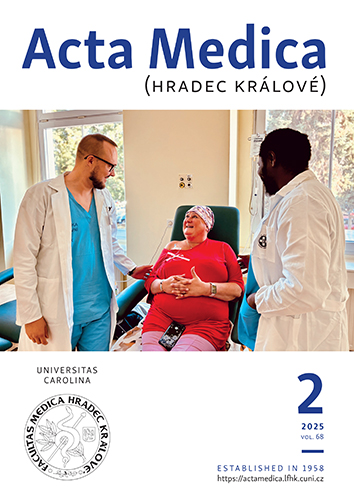ACTA MEDICA, Vol 64 No 2 (2021), 96–100
Genotype Associations with the Different Phenotypes of Atopic Dermatitis in Children
Volodymyr Dytiatkovskyi, Tetiana Drevytska, Tetiana Lapikova-Bryhinska, Victor Dosenko, Olexandr Abaturov
DOI: https://doi.org/10.14712/18059694.2021.17
published online: 02. 08. 2021
abstract
This study deals with detecting the associations of atopic dermatitis’ (AD) phenotypes in children: alone or combined with seasonal allergic rhino-conjunctivitis (SARC) and/or perennial allergic rhinitis (PAR), and/or with bronchial asthma (BA) with single nucleotide polymorphisms (SNP) of filaggrin (FLG), thymic stromal lymphopoietin (TSLP) and orsomucoid-like-1 protein 3 (ORMDL3) genes. Male and female pediatric patients aged from 3 to 18 years old were recruited into the main (AD in different combinations with SARC, PAR, BA) and control groups (disorders of digestives system, neither clinical nor laboratory signs of atopy). Patients were genotyped for SNP of rs_7927894 FLG, rs_11466749 TSLP, rs_7216389 ORMDL3 variants. Statistically significant associations of the increased risk were detected of AD combined with SARC and/or PAR and AD combined with BA (possibly, SARC and/or PAR) with C/T rs_7927894 FLG and T/T rs_7216389 ORMDL3 genotypes. Genotype C/C rs_7927894 FLG significantly decreases the risk of AD combined with SARC and/or PAR by 2.56 fold. Several genotypes’ associations had a trend to significance: C/C rs_7216389 ORMDL3 decreases and C/T rs_7216389 ORMDL3 increases the risk for developing AD alone phenotype; A/G rs_11466749 TSLP decreases the risk of AD combined with BA (possibly, SARC and/or PAR) phenotype development.
keywords: atopic dermatitis; children; genotype; phenotype; associations; filaggrin; thymic stromal lymphopoietin; orsomucoid1-like protein 3

Genotype Associations with the Different Phenotypes of Atopic Dermatitis in Children is licensed under a Creative Commons Attribution 4.0 International License.
210 x 297 mm
periodicity: 4 x per year
print price: 150 czk
ISSN: 1211-4286
E-ISSN: 1805-9694
